
Photo Credit: © 2019 James Frank
Nature Notes
Learn interesting facts about wildlife and the natural world in Rocky Mountain National Park month-by-month from a local nature guide.
Text and most photos provided by Jared Gricoskie of Yellow Wood Guiding. Find out how you can book your own guided tour of RMNP by visiting his website.
Choose a topic or month and learn a fact:
- Lichen Do What to Rocks?
- January– What animal is called a Slouch?
- February – Is the Park Alive in Winter?
- March– Do Elk Lose their Antlers Every Year?
- April– Who Wakes Up for Spring?
- May – What is the Wettest Month?
- June – Who is Having Babies?
- July – Circumpolar Artic Flora, Say What?
- August – What are Elk Antlers Made Of?
- September – When is Fall on Trail Ridge Road?
- October – Looking for Gold?
- November – Time for the Mule Deer?
- December– Time for the Big Horn Sheep?
- Winter – Do Big Cats Live in RMNP?
How RMNP was Made – The Surprising Role of Lichen

Perhaps one of the most under-appreciated life forms in Rocky Mountain National Park are the large variety of lichens growing on the rocks and trees.
Not only are lichen colorful and an important food source for the park’s beloved elk, but they actually played an important role in creating RMNP as we know it.
Lichen are an amazing combination of fungus and algae that take in nutrients from the air, as well as through photosynthesis.
But it is the role lichens played approximately 16,000 years ago that we owe a little respect. At that time, the glaciers receded from the lower parts of the park.
Lichens were some of the original colonizers on the newly exposed rocks. Over time, lichens’ small threads (called hyphae) that attach them to their rocks grow into the smallest cracks in the rock.
Gradually these cracks get larger and allow water to freeze and thaw thousands of times. This process is what eventually breaks the largest rocks into tiny pebbles. Breaking down rocks this way is what allows plants and tress to move into an area that was previously barren rock.
Even though lichens play a vital role in the ecosystem by creating soil and providing a hospitable environment for plants, and essential nutrients to many of the park’s fauna, most people won’t give them a second glance.
Maybe next time you are out exploring Rocky Mountain National Park, you’ll take a moment to appreciate the beauty and power of the humble lichen.
January – Don’t be a Slouch in the New Year!
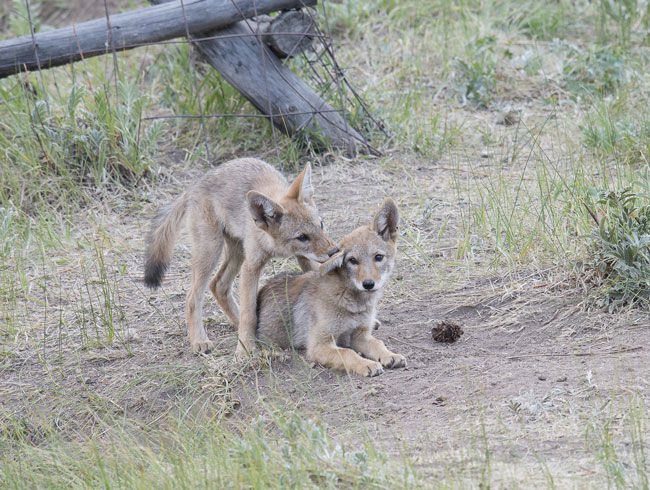
As the New Year rolls in, humans aren’t the only creatures getting used to the changes winter brings.
The animals of Rocky Mountain National Park are experiencing winter in full swing, and the new crop of coyote pups are no exception.
In areas like Rocky Mountain National Park where hunting is not permitted, coyotes often form long relationships, producing pups with the same mate year after year.
Each year, some of these lucky pups are granted the privilege of living in their parents’ territory and helping to raise the next litter of pups.
These select coyotes learn how to raise pups, share food, and some of the female yearlings may even nurse the new pups.
The yearlings that are not selected to stay head off to find a mate and a new location to call home – often miles from their parents’ home range.
Perhaps all too similar to the human parents’ plight, there are a small number of coyote yearlings who don’t venture off to forge their own family or help mom and dad out, while still living in their parents’ home range.
These coyotes are called slouches.
February – RMNP in Winter: A Park Alive!
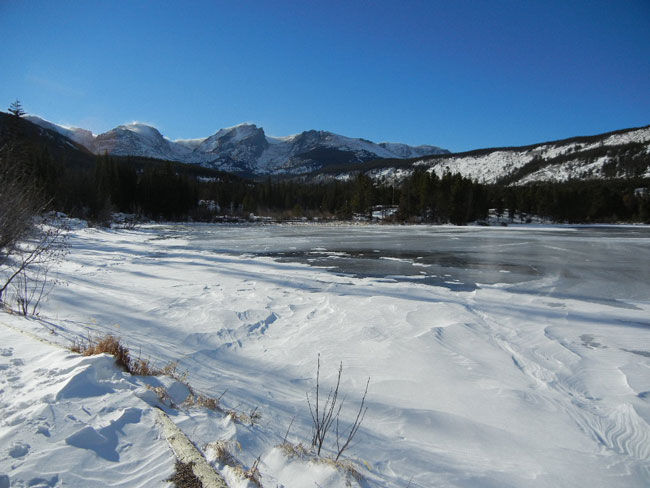
February is generally the dead of winter in Rocky Mountain National Park, but it can also be one of the most beautiful and captivating times of the year.
The thought of an icy landscape, bare branches, and howling winds conjures up images of stagnancy and hibernation – though this time of year is more alive than one would think if you are willing to look closely!
Even the ice on Rocky’s subalpine lakes that we think of as a frozen solid is moving and shifting as it constantly freezes and refreezes while the temperature fluctuates and the wind blows.
The sights of the undulating ripples of ice can transport you into another world…that is until a 30 mph gust of wind jolts you back to reality!
Even the rivers come alive with the ice. Imagine walking down the river beds as they wind through the Park’s meadows, catching glimpses of a coyote against the snowy back-drop, and following the tracks of an elk as he uses the river bed as an easy winter route to travel.
If you’re more of an armchair adventurer, you can even enjoy some of these wintry sights from the warmth of your car: just drive into Rocky Mountain National Park on Bear Lake Road.
March – Yes, Elk Loose Their Antlers Every Year

One of the most common questions I get on tours is, “Do the elk lose their antlers every year?”
The answer is yes, the antlers of nearly all deer species (US deer include: mule deer, white-tailed deer, elk, moose, caribou) on the planet are annually deciduous.
Or, in layman’s terms, they fall off every year and then grow again. Mid-March is when bull elk cast off their antlers and within days of dropping, their new antlers start to grow.
Once those antlers hit the ground, they still play an interesting role in the ecosystem.
Antlers are vital for small mammals as sources of calcium, potassium, and protein – which explains why you are not allowed to take them home with you as a souvenir of your visit to RMNP!
April – Rocky Mountain National Park is Waking Up for Spring!
April is a time when much of the country is warming up, but when you visit Rocky Mountain National Park in April, don’t get fooled.
April is typically one of the snowiest months of the year, so don’t be surprised if we still get a few more tastes of winter.
April is an exciting month due to that unknown. The hibernating animals are awakening, some birds are migrating, and it can go from sunny to blizzard in the span of a day.
April is a great time to be in the park, just make sure you are prepared for all the potential outfit changes from shorts and t-shirts to parkas and snowshoes!
However, even when “spring” looks a lot like winter, there are some tell-tale signs that warmer weather is on its way.
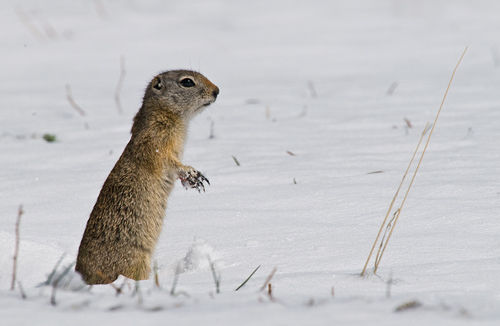
One such sign happens every April, as many of RMNP’s small mammals come out of hibernation. The Wyoming Ground Squirrel, like you see in the above picture, are generally seen in the first week of April.
When they emerge it is the first time they’ve seen the sun in nearly seven months! These amazing creatures eat meadow grass in the park, and play an important role in the ecosystem.
Each family of Wyoming Ground Squirrels creates a burrow system that includes a restroom chamber. Since they mostly eat grass and seeds, some of these seeds do not get digested and are “planted” in the chamber.
Wyoming Ground Squirrels are cute and fuzzy, and because they hibernate more than 50% of their lives, are not the smartest animals.
This works out well for predators in the park, making them easy summer time prey.
May – The Month of Change in RMNP
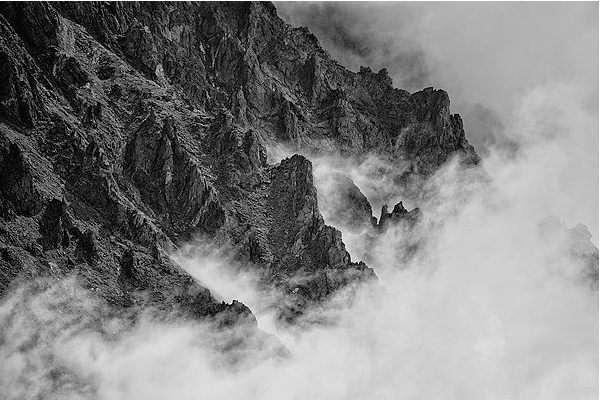
The first real signs of spring in Rocky Mountain National Park arrive in May.
In a mere 3 weeks all the meadows will be green and lush. The dead tan grass will give way to wildflower patches dotting the landscape.
The river will swell nearly above its banks as the spring snow melts. The snowy peaks will keep their white caps, but the weather pattern will finally change to offer us more clear mornings and less chance of a snow storm. Note I said “less chance.”
May is the season for migrating birds, each year some rare birds show up around Estes Park.
Probably the most enchanting change of May will be the arrival of baby animals at the end of the month like elk calves to baby birds. The park really comes alive in May.
May is the wettest month in Rocky Mountain National Park. Each year brings the familiar pattern of spring snows relenting to warmer days, only to quickly return with more snow and rain showers.
Contrary to what you might think, it’s a great time to be in the park (providing you are properly outfitted for the weather).
With all the precipitation comes thousands of small flowers, green grass, and many opportunities for roadside sightings of wildlife.
Since the grass is so short, May is an ideal time to watch coyotes, and if you’re lucky, you might be able to see badgers hunt for fossorial mammals.
Early in the month of May it is a good time to spot the big horn sheep up close – often on the side of the road on Route 34.
If you plan on coming for a visit to Estes Park and RMNP in May, bring a parka and boots you can get muddy.
Plan to stay for about a week if you can, because on the days with poor weather you can spend them looking for wildlife, and when the sun comes out you can enjoy an amazing hike!
June in Rocky Mountain National Park: It’s Baby Time!
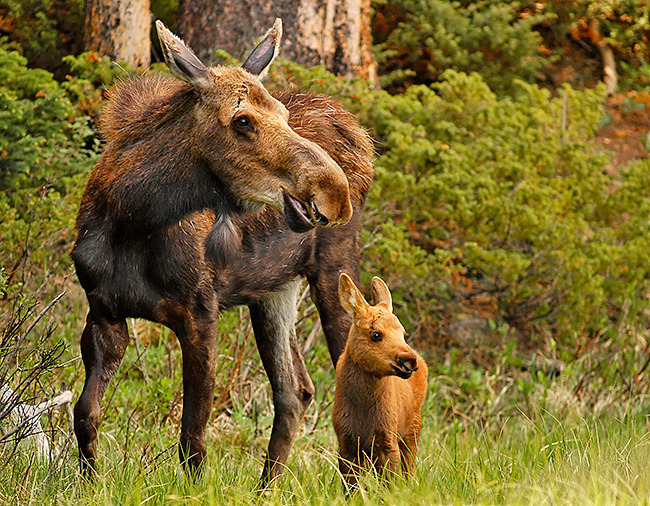
The month of June is “baby time” all over the park.
Predators like coyotes, give birth about a month before the herding species. Early June is a great time to see coyote puppies and Great Horned Owlets.
By mid-month, many of them will be well on their way to adulthood, which means eating solid food prey. On the other hand, elk, moose calves, mule deer fawns, and big horn lambs will still be nursing for another month.
Early June is when most of the babies of RMNP arrive.
After birth the elk calf spends most of its time hiding in grass or near bushes and following it’s mother as she grazes. Nature is momentarily kind during the elks’ first week of life – the baby doesn’t produce a scent for nearly a week to help allude predators.
This reprieve is short lived though, as June is a calf’s most dangerous time when predators like coyotes are prowling the edges of elk herds looking for a baby hiding in the grass.
Generally the mothers form very small herds and the calves start playing with other calves, learning how elk life works.
From birth until mid-July the calf will drink about a gallon of milk a day gaining two to three pounds a day.
Life gets even harder just a few weeks, or sometimes only days after birth, as the elk herds start to move up to the tundra and the calf has to hike miles gaining 5,000 feet of elevation to start enjoying the tundra’s sweet grass.
Luckily, each calf has plenty of babysitters with the rest of the elk herd watching after them.
Spying a mother nursing her young, or playful pups wrestling are sweet moments to witness in the wild, so be sure to keep your eyes peeled for them as you travel through RMNP this month!
July – Tundra in Bloom
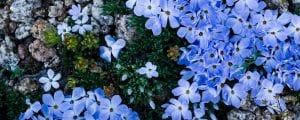
The tiny plants that live in the harsh tundra world are called “circumpolar” because the same plants are found all around the earth.
They have a short flowering season, and if you hit it just right, you will be treated with their incredible beauty. It sometimes seems miraculous that they can survive at high altitude.
When you drive to the top of Trail Ridge Road, take a break and hike the Rock Cut Trail to see these miracles of nature.
August – Month of Transition in RMNP

August is a month of transition from summer into fall.
By late August the tundra turns its fall colors. The juvenile animals are starting to head out on their own, so sightings of coyotes and badgers are on the rise.
Up by tree line the Elk are searching for various plants with high calcium and potassium levels to help solidify their antlers.
Antlers are roughly 50% protein, 30% calcium and 20% potassium, and the last month prior to the velvet coming off is when they finally turn into hard bone for their fall fights.
Generally around August 15th you’ll see bull elk losing their velvet. Keep your eyes peeled for the elk’s fresh white and sometimes bloody antlers.
September – Last Chance to Enjoy Trail Ridge Road
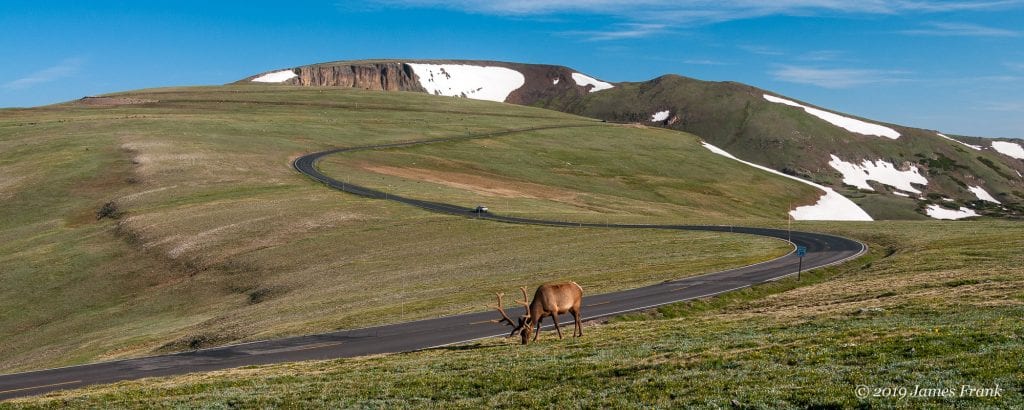
Many people will tell you that the highlight of their trip in Rocky Mountain National Park was a trip over Trail Ridge Road.
The striking beauty around every curve is overwhelming for many who drive this grand road. But when September arrives, the days to travel over Trail Ridge are numbered.
The tundra plants have been prepared for the brief summer, some for nearly the last century, each time fall arrives they draw their reserves into their roots, turn yellow, burnt orange or red and then finally brown to wait out yet another winter.
Tundra fall is a brilliant display in this 4 inch forest.
Much like the flowers, the next time we’ll visit the tundra is when the first warm rays of summer arrive next May.
So if you have the privilege to drive over Trail Ridge during September enjoy the colors and remember much like the summer flowers, we are just brief visitors to this grand landscape.
October – Little Known Facts about Rocky Mountain Gold
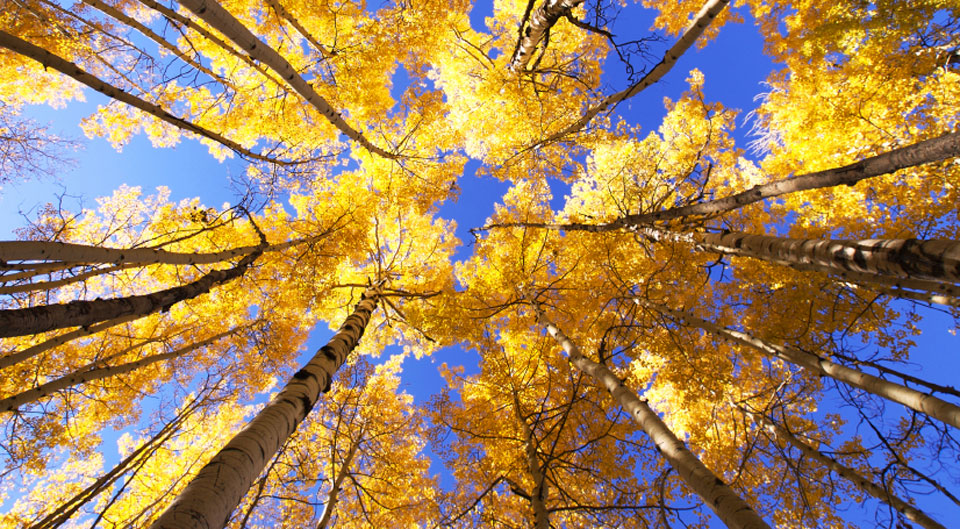
Each fall the aspen slowly show the signs of a new winter approaching.
The colors: yellow, orange, and red (although this is rare!) paint the hillsides of Rocky Mountain National Park. The brilliant color may quickly fade, but it marches down the mountain side well into mid-October.
Beyond their dramatic color, aspen play an important role in the ecosystem as food for elk, deer, beavers, and a number of other rodents living under and around their distinctive white trunks.
When you see a grove of aspen, it’s likely you are actually looking at just one tree with many trunks connected by the root system.
Native peoples would sometimes rub the inner bark to use as a form of sun screen.
Aspen bark also contains the active ingredient for aspirin, so native peoples and fur trappers collected beaver castor glands which concentrated the chemicals in the aspen bark to be used in teas to reduce fever and headache.
RMNP’s aspen have been heavily over-grazed by elk in the past, so many of the lower groves are now protected by fences. Thankfully, with the exclusion fences in place we will enjoy the yearly show of gold for centuries to come.
For a great October experience, find a grove that’s in full color and take a stroll! You might emerge feeling just a bit richer….
October is also a great month to photograph the subalpine lakes in Rocky.
Often the lakes have just started to freeze or may still be open so you can get some amazing reflections as well as shiny ice.
Be sure to dress extremely warm if you shoot sunrise, and know your trails well as they often get snow covered.
Pro tip: don’t take your gloves off to take the shot. Your fingers will thank you greatly.
Great spots would be Dream, Mills, Loch, Haiyaha, Helene, Two Rivers, and a hand full of other lakes in the Bear Lake area.
November – is Mule Deer Time
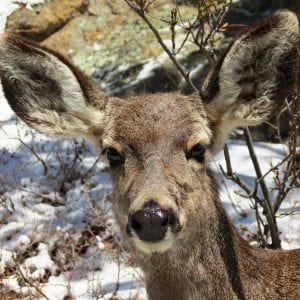
November may not win any popularity contests like the month of July. It doesn’t have roving fans following the elk rut like September. The glorious autumn gold has pretty much given way to a landscape that more resembles winter.
But in November, the mule deer pick up the “love in the air” where the elk left off the previous month.
When it comes to impressing the ladies, mule deer are no schmucks. The males grow large, splitting antlers, their necks enlarge, and their coats become nice and thick for the start of winter.
Females don’t form large herds, but they stay in small groups throughout the lower portions of Rocky Mountain National Park.
The males roam the hillsides, smelling for females that come into estrus for only about 10 hours. Usually one female at a time goes into estrus, so finding those girls on time is very important.
Sometimes more than one male shows up to impress a girl. When this happens a fight or chase is likely to occur.
Visitors to the park this month should keep their eyes peeled for mule deer playing the game of love!
December – Big Horn Sheep … Love on the Rocks
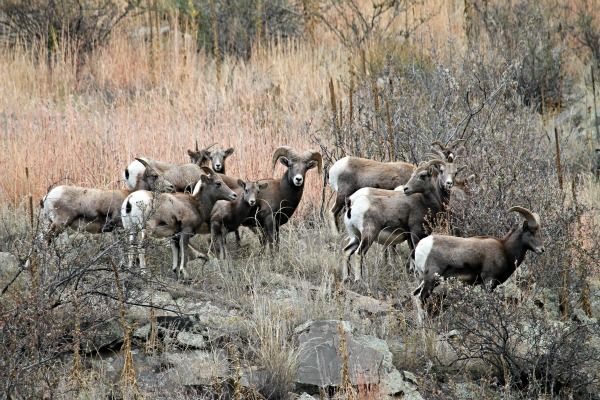
Here in Rocky Mountain National Park, December is the Big Horn Sheep’s mating season.
Big Horns spend most of the year in small bands of females and lambs, with the males in separate bands of mixed ages. Most of the time females just want to eat grass (generally on a southern facing slope).
But for as little as 48 hours a year, the ladies are in estrus and looking for the right guy. During these extremely brief mating periods, females attract males through scent and may attract more than a handful of suitors.
Females select males on a basis of body size, horn size, and fitness. They attract a few males and then run, much like a scene from a schoolyard where the boys chase the girls.
During the pursuit, the lead male will often turn on the males behind him and clash. The sounds of the two rams crashing their heads together can be heard from over a mile away.
In the end, the female selects a male to mate with and will very likely not interact with him again.
Generally, the most exciting thing to watch is surprisingly not the largest males. It’s the medium sized guys (the ones who don’t get the girl) that provide the best show.
These poor losers have a lot of extra time on their hands, and a lot of extra testosterone! So, they often take out their hormone driven aggression on each other by smashing their heads together.
So be sure to scan the rocky southern facing cliffs around Estes Park during the first two weeks of December. For Big Horn Sheep, love really is on the rocks.
Winter Wonderland – Tiny Wonders, White Rabbits, and rare sightings of Bobcats

Tiny Wonders – Frost
Did you know there are different kinds of frost? Next time you have to clean off your windows on a cold morning, take a minute to look closely – you might be surprised!
One of the most beautiful kinds of frost is called Hoar Frost. It generally appears after a day of temperatures above freezing, followed by an extremely cold night with mid to high humidity.
The end result is amazing fern-like ice structures covering nearly everything from grass blades to tree limbs. It’s caused by the crystal structure of water and the way it freezes.
If you are brave enough, head out to a watery area after a warmer day and cold night and check out the miniature beauty. By 9:30 am the hoar frost will usually all be gone, so soak in the tiny magic and then go warm your toes in the car!
White Rabbits?
If you go out snowshoeing through the wonderland that is Rocky Mountain National Park, you might just spot the white rabbit. Well…it’s not actually a white rabbit, it’s a hare: a Snowshoe Hare.
The main differences between rabbits and hares is that hares give birth to furry young with their eyes open and ready to run.
Snowshoe hares use their huge hind feet to stay on top of the snow, and they are one of the few animals to take advantage of the snowy landscape to reach new resources.
With multiple feet of snow on the ground, snowshoe hares can reach tree buds many feet higher than they’re able to in the summer months.
Snowshoe hares use their white coats to stay camouflaged, but you can generally find their tracks that look like repeating T’s. They need to camouflage to hide from coyotes, lynx, bobcats, mountain lions, and even owls and hawks.
They are mostly nocturnal and have huge black eyes which make them look very sweet. So come to the park with snowshoes on your own feet and keep your eyes peeled for the telltale T tracks in the snow. You might just spot a furry snowball with big black eyes!
Rare Bobcat Encounters
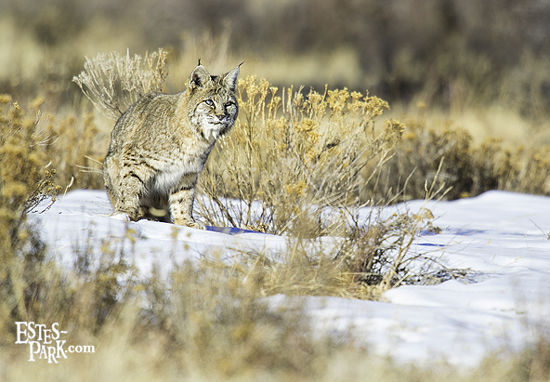
Being out in Rocky Mountain National Park on a nearly daily basis, I find you start to really appreciate how rare some moments can be. One of those moments – that I get to experience only two or three times a year – is to see a bobcat, especially in the daylight.
Coyotes, bobcats, and even mountain lion juveniles start to disperse in the winter months. If you are brave enough to head out in the park in the cold, you just might be the lucky enough to experience one of these rare sightings.
The bobcat above crossed in front of me while I was out on a Wildlife Tour. It was calm and even spent a few moments sitting on top of a large rock, seemingly being polite enough to stick around while I assembled my camera setup.
It went into the bushes and tried to hunt for a while, and then unfortunately some folks pulled up, flung their car doors open and made a lot of noise. The bobcat was spooked and headed into the woods.
So if you ever find yourself out in RMNP and have the fortune to sight one of these magnificent creatures, please be sure to move slowly and quietly.
Find a legal place to park, and you might just get to spend a few moments with one of the Park’s illusive animal residents.
